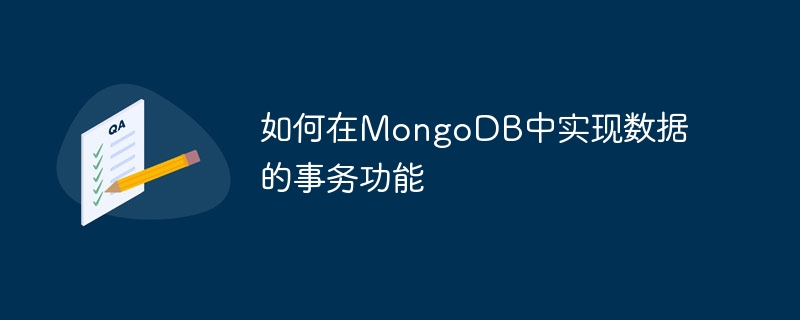How to implement data transaction functions in MongoDB

How to implement data transaction functions in MongoDB requires specific code examples
Overview:
MongoDB is a non-relational database, and its default data operations are The approach is non-transactional. However, in some application scenarios, we need to ensure the transaction consistency and atomicity of the database. Since MongoDB version 4.0, the official transaction function has been launched, allowing developers to implement data transaction functions in MongoDB.
Transaction:
Transaction refers to the process of executing a set of database operations as a logical unit. Each operation in this set of operations is either executed successfully or not executed at all, thereby ensuring data consistency. In MongoDB, transactions can ensure that operations and queries on multiple documents either all succeed or all fail.
Code example:
The following is a simple code example that demonstrates how to implement data transaction functions in MongoDB.
-
Create a MongoDB connection:
from pymongo import MongoClient # 创建MongoDB连接 client = MongoClient('mongodb://localhost:27017') db = client['mydatabase']Copy after login Open a transaction:
with client.start_session() as session: with session.start_transaction(): # 在此处执行事务操作Copy after loginPerform transaction operations :
from pymongo.errors import OperationFailure def execute_transaction(session): try: # 执行具体的事务操作 # 插入数据 collection.insert_one({'_id': 1, 'name': 'Alice'}, session=session) # 更新数据 collection.update_one({'_id': 1}, {'$set': {'age': 20}}, session=session) # 删除数据 collection.delete_one({'_id': 1}, session=session) except OperationFailure as e: print(f'Transaction failed: {str(e)}') session.abort_transaction() # 事务失败,回滚操作 return False return TrueCopy after loginCommit or rollback the transaction:
After the transaction operation is completed, you need to decide whether to commit the transaction or rollback the transaction based on the result of the operation.with client.start_session() as session: with session.start_transaction(): # 执行事务操作 success = execute_transaction(session) if success: session.commit_transaction() # 提交事务 else: session.abort_transaction() # 回滚事务Copy after login
Summary:
Using MongoDB's transaction function can implement transactional operations on data in a non-relational database. Through reasonable organization of operation steps and reasonable exception handling, developers can ensure the consistency and atomicity of database operations. Note that the transaction function is only available in MongoDB replica sets and sharded clusters. Single-node MongoDB does not support transactions.
The above is the detailed content of How to implement data transaction functions in MongoDB. For more information, please follow other related articles on the PHP Chinese website!

Hot AI Tools

Undresser.AI Undress
AI-powered app for creating realistic nude photos

AI Clothes Remover
Online AI tool for removing clothes from photos.

Undress AI Tool
Undress images for free

Clothoff.io
AI clothes remover

AI Hentai Generator
Generate AI Hentai for free.

Hot Article

Hot Tools

Notepad++7.3.1
Easy-to-use and free code editor

SublimeText3 Chinese version
Chinese version, very easy to use

Zend Studio 13.0.1
Powerful PHP integrated development environment

Dreamweaver CS6
Visual web development tools

SublimeText3 Mac version
God-level code editing software (SublimeText3)

Hot Topics
 1378
1378
 52
52
 What are the different types of indexes in MongoDB (single, compound, multi-key, text, geospatial)?
Mar 17, 2025 pm 06:17 PM
What are the different types of indexes in MongoDB (single, compound, multi-key, text, geospatial)?
Mar 17, 2025 pm 06:17 PM
The article discusses various MongoDB index types (single, compound, multi-key, text, geospatial) and their impact on query performance. It also covers considerations for choosing the right index based on data structure and query needs.
 How do I create users and roles in MongoDB?
Mar 17, 2025 pm 06:27 PM
How do I create users and roles in MongoDB?
Mar 17, 2025 pm 06:27 PM
The article discusses creating users and roles in MongoDB, managing permissions, ensuring security, and automating these processes. It emphasizes best practices like least privilege and role-based access control.
 How do I use MongoDB Compass for GUI-based management and querying?
Mar 17, 2025 pm 06:30 PM
How do I use MongoDB Compass for GUI-based management and querying?
Mar 17, 2025 pm 06:30 PM
MongoDB Compass is a GUI tool for managing and querying MongoDB databases. It offers features for data exploration, complex query execution, and data visualization.
 How do I choose a shard key in MongoDB?
Mar 17, 2025 pm 06:24 PM
How do I choose a shard key in MongoDB?
Mar 17, 2025 pm 06:24 PM
The article discusses selecting a shard key in MongoDB, emphasizing its impact on performance and scalability. Key considerations include high cardinality, query patterns, and avoiding monotonic growth.
 How do I configure auditing in MongoDB for security compliance?
Mar 17, 2025 pm 06:29 PM
How do I configure auditing in MongoDB for security compliance?
Mar 17, 2025 pm 06:29 PM
The article discusses configuring MongoDB auditing for security compliance, detailing steps to enable auditing, set up audit filters, and ensure logs meet regulatory standards. Main issue: proper configuration and analysis of audit logs for security
 What are the different components of a sharded MongoDB cluster (mongos, config servers, shards)?
Mar 17, 2025 pm 06:23 PM
What are the different components of a sharded MongoDB cluster (mongos, config servers, shards)?
Mar 17, 2025 pm 06:23 PM
The article discusses components of a sharded MongoDB cluster: mongos, config servers, and shards. It focuses on how these components enable efficient data management and scalability.
 How do I implement authentication and authorization in MongoDB?
Mar 17, 2025 pm 06:25 PM
How do I implement authentication and authorization in MongoDB?
Mar 17, 2025 pm 06:25 PM
The article guides on implementing and securing MongoDB with authentication and authorization, discussing best practices, role-based access control, and troubleshooting common issues.
 How do I use map-reduce in MongoDB for batch data processing?
Mar 17, 2025 pm 06:20 PM
How do I use map-reduce in MongoDB for batch data processing?
Mar 17, 2025 pm 06:20 PM
The article explains how to use map-reduce in MongoDB for batch data processing, its performance benefits for large datasets, optimization strategies, and clarifies its suitability for batch rather than real-time operations.




